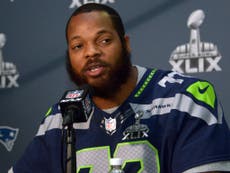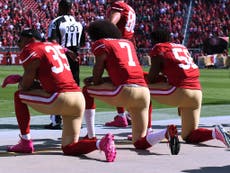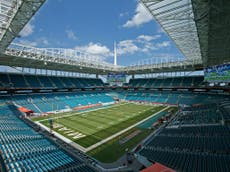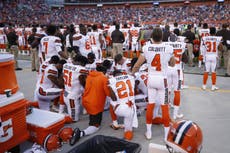Why I'll be tuning in to NFL this season, despite the moral question over brain damage
So far, only a very small number of spectators have proved willing to turn their back on the game, despite the mounting weight of evidence that it can seriously damage the health of the people that play it


As the NFL kicks off its new season, how long before one of the its biggest stars goes down after a crunching hit and finds themselves in its concussion protocols?
With Sunday featuring nearly a full slate of week one games, it mightn’t even take a quarter (15 minutes).
“Are you ready for some football brain damage?” asked the editorial board of USA Today on Monday.
Millions of Americans, and millions of Britons too, will say yes, at least to the first part.
The second part? Those of us who think about it will probably push it to the backs of our minds when the games are being screened, otherwise it might be too hard to watch.
And watch we will.
So far, only a very small number of spectators have proved willing to turn their back on the game, despite the mounting weight of evidence that it can seriously damage the health of the people that play it, just as only a minority of players are calling time on their careers early.
What prompted me to consider whether I should was the discovery that my esteemed colleague John Rentoul is one of those to have done so.
His decision came in the wake of the publication of a Boston University study of the brains of deceased former players. Some 110 of the 111 that its researchers looked at showed evidence of degenerative brain disease.
It should be said, at this point, that the study ultimately raises more questions than it answers.
The researchers did not consider a representative sample of former NFL players. The majority of the brains scrutinised were those belonging to players whose relatives were concerned that their loved ones had displayed the symptoms of chronic traumatic encephalopathy (CTE).
With the science very much in its infancy, it is completely impossible to gauge how many current NFL players are at risk of contracting the disease, or even to effectively quantify the risks they are taking by playing.
What other work by the university suggests, for example, is that those risks are greatly increased if they were among those who played full contact football when they were young, when their brains were still developing.
The only thing we can say with cast iron certainty is that the risk is there. And it might be quite high. And yet I’ll still be watching.
I could say at this point that the NFL is far from the only sport that might cause spectators to question why they indulge if they’re being honest with themselves.
Many, perhaps even most, sports have their dark side and if the NFL puts its players at risk, at least the same cannot be said of the people who build its stadia, by contrast to those who have been erecting the venues for the World Cup of another game called football in Qatar.
I could also point to the positives cited by those that have played. I could draw your attention to the route out of poverty it offers some seriously deprived kids, many of whom don’t have any other options.
I could point to the social consciousness of its players, the bravery displayed by those who have sought to draw attention to the injustices meted out to African Americans via the recent spate of national anthem protests.
But I also have to be honest. Part of the reason I’m still watching the NFL is that I’m an atavistic thrill seeker.
It is the nearest thing we have in our semi-civilised modern age to the gladiatorial games of the Roman era. It’s exciting, strategic, tactical. It’s chess with violence.
It is also a habit, one that I’ve had for more than 30 years. It doesn’t hurt that the Oakland Raiders, who I’ve followed through thick and (more often) thin, finally look good.
Watching it helps me blow off steam, and makes Sunday nights easier to deal with. That’s something I’m sure is true of millions of others.
Yes it’s morally ambiguous. But we all have our vices, don’t we.
That’s not to say that I wouldn’t like to see the sport made as safe as possible.
I’m not one of those trolls that drools over the most violent, bone-crunching hits, or buys pornographic DVDs fixating upon them.
I get far more out of watching Derek Carr launching bombs downfield with pinpoint accuracy into the hands of Amari Cooper or Michael Crabtree.
As I noted, only a small trickle of players have chosen to shun the sport, even now that there is more awareness of the risk that it poses.
Chris Borland made headlines a couple of years ago when he quit after just a season, despite having emerged as one of the NFL’s top rookies. He specifically referenced the risks of head trauma, making the decision after consulting with experts and former players.
More recently John Urschel, an offensive lineman with the Baltimore Ravens, called time on his career after three years. He will trade the football field for the classrooms of the prestigious Massachusetts Institute of Technology (MIT) where he plans to study for a PHD in mathematics. He didn’t specifically mention head trauma in announcing his decision, but the Baltimore Sun, citing team sources, said that was the reason.
In between those two there have been few others. AJ Tarpley, the Buffalo Bills linebacker, New York Jets tackle D’Brickashaw Ferguson, Anthony Davis, of the San Francisco 49ers, New England Patriots receiver Andrew Hawkins.
Far greater numbers appear to be of the view of JJ Watt, the anchor of the Houston Texans’ scary good defence, who said in an interview with Peter King from the MMQB (Monday Morning Quarterback) website: “I know what I’m getting into. I know that I’m going out there and I know that I am going to get hit in the head… I choose to continue doing it. That’s my choice. If I wanted to walk away, I could.”
While he’s prepared to make that trade-off, so am I.
Part of doing so, however, does for me mean supporting the players in their efforts to secure better treatment, and, yes, more money, from the NFL owners, ultra-rich men who have gotten even richer off their backs.
There is a good chance that there will be a strike or a lockout when the current owner-friendly collective bargaining agreement ends.
It’s often stated that a labour dispute would pit millionaires against billionaires and many fans will be furious: Just play already!
When average Americans (and average Britons) are struggling, it’s understandable.
But given that the millionaires put their bodies at risk for our entertainment, we NFL fans should support their claims for a fairer share of the spoils.
Compared to other US sports they’re not all that well paid, certainly not when you consider the average Joes playing below the level of the stars.
Matt Stafford, the Detroit Lions’ quarterback, might have become the league’s highest paid player on $27m a year, but most earn only a tiny fraction of that.
It’s rare for an NFL player to make it past their rookie deal. If they’re sensible they’ll emerge with a nice nest egg, but that’s about it.
It’s not just to assuage a guilty conscience that I stand with them.





Join our commenting forum
Join thought-provoking conversations, follow other Independent readers and see their replies